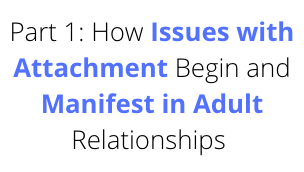Part 1: How Issues with Attachment Begin and Manifest in Adult Relationships
Psychology has taught us a lot about the way human bonds are formed. We now know that attachment begins far earlier than we ever thought possible, in utero. When we are fetuses, the way our mothers experience the world influences our development.
Stress, feelings about the pregnancy, and her ability to attend to her own (and therefore our) needs, all influence fetal development. The way our brains and emotions develop, based on these early experiences create a baseline for how we attach to others throughout our lives. Adult attachment is influenced by our experiences in utero, infancy and throughout our developmental stages of life.
The Cortisol Factor
The stress hormone cortisol plays a significant role in the way fetuses grow and develop. High levels of stress for mothers during pregnancy means high rates of cortisol for the growing baby, and this can have a major impact on attachment. Stressed-out newborns express their discomfort in the only way they know how, by crying. Distressed, colicky babies are difficult to soothe and can cry for many hours.
In studies, colicky babies often grow into children and adolescents with emotional health challenges, and sometimes behavioral issues can manifest. Early exposure to distress (bad stress) creates high cortisol levels and can result in cognitive problems and behavioral issues during childhood.
Too little exposure to eustress (good stress) creates a deficit of cortisol, which also impacts cognitive abilities and emotional health. Excessively low cortisol can manifest later in life as depression and a pervasive sense of ennui. It turns out, there is a sweet spot for cortisol levels; getting the right kind of cortisol at the right time can impact a range of developmental factors.
Why this Matters
The way we develop attachments is rooted in our early lives. Understanding the impact of childhood experiences can help us recognize some of the attachment challenges that may emerge later in life. Attachment impacts interpersonal skills, friendships, and intimate relationships.
We tend to compartmentalize attachment as an issue of childhood, but in reality, it is an ongoing part of how we function throughout our lifespan.
There are four general types of attachment, secure, anxious-insecure, avoidant-insecure, and disorganized-insecure. Our early experiences, from the time we are fetuses, shape the way we attach to others.
We learn what to expect on a subconscious, pre-cognitive level through the hormonal and chemical messengers of our bodies. Attachment styles are formed from these early messages, and the way we respond can reinforce the attachment style over time.
What this Means for Us in Adulthood
We rarely hear much about secure attachment because people with this type of attachment are often able to form and maintain healthy connections. Insecure attachment types can create discord and challenges with connection, and this can impact adult relationships.
Having an insecure attachment style doesn’t mean you are doomed to isolation or lack of close relationships. Awareness of one’s attachment type can help identify patterns of behavior, and these behaviors can be addressed to shape the way relationships develop in the future.
Insecure-anxious attachment can manifest as codependency and fear of abandonment in adult relationships.
The fear of being abandoned by others can be crippling for those with this type of attachment style and can be exhausting for the individual and their loved ones.
Anxious attachment can result in tolerating maltreatment in some situations, and often there is a pervasive lack of self-advocacy in a variety of settings.
People who have this attachment style are more prone to distrust and low self-worth, and often experience anxiety when away from their loved ones.
In the next article of this three-part series, we will explore other types of insecure attachment and the way they influence adult relationships. Attachment styles can be adjusted when there is understanding of the deeply rooted causes and impact on relationships.
Through self-exploration and compassion, we can look at the way we experience our connections and make adjustments that improve our relationships.
